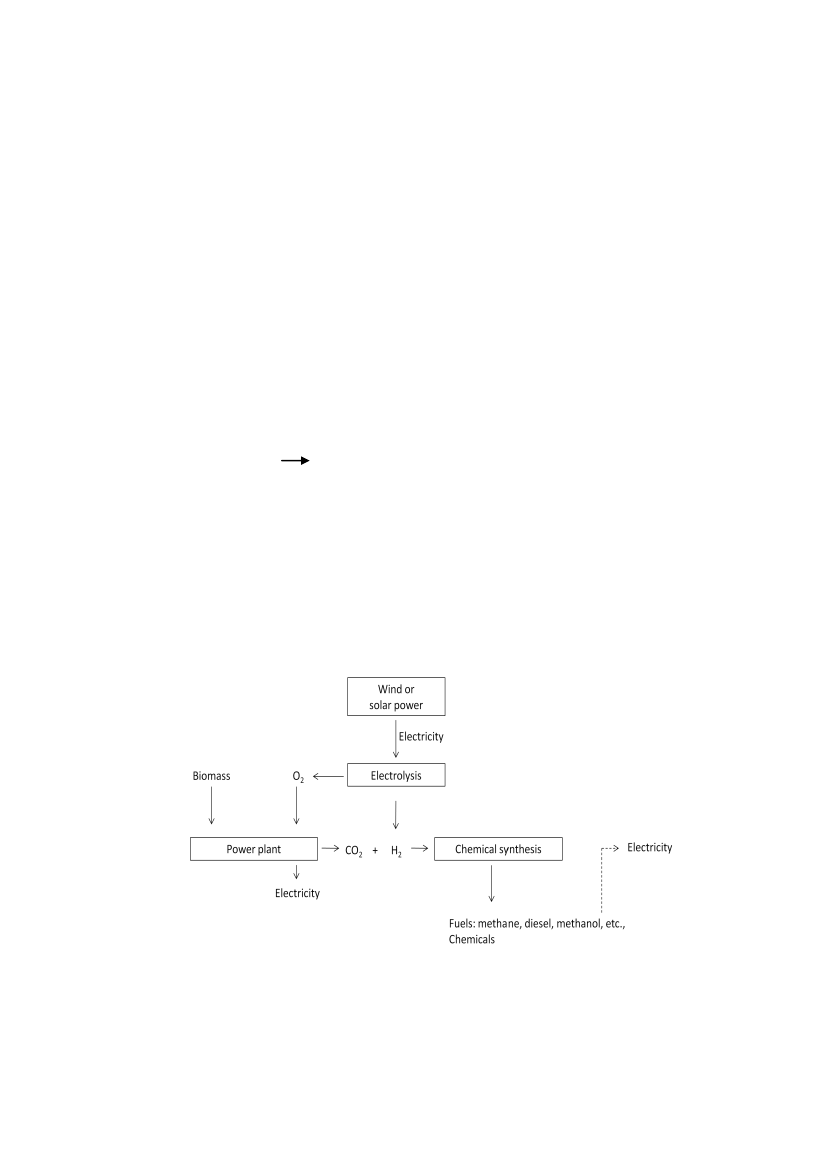Det Energipolitiske Udvalg 2009-10
EPU Alm.del Bilag 384
Offentligt
Breaking the biomass bottleneckof the fossil free societyBy Henrik Wenzel
Version 1September 22nd, 2010
1
SummaryThe focus on global warming and security of resource supply has led many sectors in society to look foralternatives to oil and other fossil resources. Biological resources – biomass in brief – is at present apreferred alternative in many sectors of society. Biomass is, thus, in growing demand for heat and powerservices as well as for transportation fuels and as feedstock for chemicals and materials – i.e. in practice allsectors today being dependant on fossil fuels.At the same time, unfortunately, the food sector is also in growing demand for agricultural crops. Worldpopulation is still growing and even more importantly, the composition of food is changing towards moremeat on the menu, especially in the many countries in economic transition towards higher welfare; i.e.China, India, Malaysia, Indonesia, South Africa, Mexico, Brazil and more. Even without the new customersfor biomass, this alone puts pressure on agricultural land and leads to new land cultivation. A look atproportions of biomass resources compared to the new customers, thus, shows that there is very far fromenough for all.The world has already had an early warning in terms of potential influences from excessive biomassdemand on food prices, namely the food crisis in 2007 – 2008. During this period, market prices on foodand feed crops increased by almost a factor of 2, and the part of the world population suffering fromhunger and starvation increased from 800 million to 900 million people.The amount of biomass that the world can sustainably use is, therefore, concluded to be small compared tothe potential demand for it. The problem is that a fossil free society implies a set of conditions that makebiomass in high demand:biomass can be stored and thus provide flexibility in electricity production,it can be converted to high-density fuels for mobility purposes, andit is a key source of carbon feedstockAll in all, everything points to the fact, that biomass (and agricultural land) may be a severe bottleneck inthe fossil free society and that excessive use can have severe consequences for the world’s forestresources, the food sector and the poorest part of the world population.We can, however, break this bottleneck. First of all, we must seek further energy savings. Secondly, weneed to look for ways to de-carbonize society. There is a growing consensus among energy scientists andenergy planners that society is heading towards increased electrification. The transport sector shall to thewidest possible extent run on electricity and domestic and district heating shall be converted to heatpumps to the extent possible. This will help pulling more wind and solar power into our systems, and it willhelp balancing electricity supply and demand from fluctuating sources, because electricity is then stored inthe batteries of the car fleet and in reservoirs for heating. Further electricity buffering can be provided bywater reservoirs for hydro power or by various means of pressure based reservoirs, and smart grids andinternational trade will further assist in the balancing.
2
But these measures are not enough. We still need high density fuels especially for aviation, but to someextent also for long distance, heavy transport on road and for sea transport. We also need carbonfeedstock for our chemicals and materials. Finally, some amount of storable fuel for providing flexibility onthe supply side of our electricity systems will be a big advantage. Looking at proportions in how muchbiomass is available without influencing the food sector shows that we have far from enough even forthese priority customers alone. We need to do something to reduce our demand for biomass further.Using hydrogen as an agent to capture the electricity from wind and solar power through electrolysis is anobvious route to follow. This is judged to be a significant part of the solution. But storing and transportinghydrogen is not easy, and due to this it may be attractive to use hydrogen as an intermediate energy carrierfor the final production of carbon based fuels and feedstock.In this way, using hydrogen to upgrade and recover carbon from biomass may well be the final keystone forthe successful fossil free society. Through a process called hydrogenation it is possible to use biomass as asource of carbon and react hydrogen with it to produce hydrocarbons of much higher energy content andenergy density than the original biomass. Moreover, using the biomass and the biogenic carbon fromhydrogenation in central applications like heat and power, it is possible to collect the CO2from the biomassand further recover and recycle it in a process here called Carbon Capture and Recycling, CCR. This willfurther multiply the use of the biogenic carbon from the biomass.Overall, upgrading and recycling biogenic carbon by hydrogenation and CCR, can approximatelyfive-doubleour biomass potential for providing storable and high-density fuels and carbon feedstock compared to thepresently applied technologies for converting biomass to fuels and feedstock. This can fully and effectivelybreak the biomass bottleneck of the fossil free society.In this way, wind and solar power can save nature and land for food production. Assuming the nextgeneration 6 MW wind mill, it is found that
one off-shore wind mill can save 5 km2of nature or agricultural landequivalent to 2500 tons of food crop kernels per year equal to theaverage calorific intake of food for 10000 peopleIn a Danish fossil free society we seem to lack 160 PJ of biomass residue. We could import this or produceenergy crops ourselves, and for the purpose we would need 8000 km2of arable land equal to 30 % ofDanish agricultural land. Or we could follow a wind-for-biomass strategy and put up1600 off-shore 6 MWwind mills and create the 160 PJ extra biogenic fuel and feedstock by hydrogenation and CCR. By doingthis, we would then save these 8000 km2of nature or agricultural area and food production equivalentto the calorific food intake of 16 million average world citizens.The cost of CCR is greater than the fossil fuels of today, but the extra cost of it still only amounts to around2-3 % of Danish GDP. In this cost estimate, the benefits of ultimately ensuring supply security of energy andchemical feedstock, ultimately reducing greenhouse gas emissions, avoiding food crises due to excessiveuse of land for energy crops, and avoiding cutting down virgin forest are not included.A road map to the sustainable use of biomass and land for energy and material feedstock purposes shouldbe developed. In doing this, we should aim at using biomass residues only, i.e. co-products and wastes3
deriving from food production, forestry, industry, households, etc. We should distinguish between residuestypes and respect the special compositions and contents of these in terms of carbohydrates, nutrients(especially phosphorus), and proteins.It is tempting to conclude that manure and other wet residues should be reserved for biogas, and that thebiogas should subsequently be hydrogenated and stored in the natural gas grid. Wooden, mainlycarbohydrate containing residues should be hydrogenated to upgrade their energy content and quality upfront. And care should in general be taken to use biogenic carbon at central applications as a first caseallowing for a subsequent capture and recovery of the biogenic carbon. When finally converted to transportfuels, the carbon is lost with photosynthesis as the only subsequent way of recovery, and photosynthesis isunfortunately very slow in comparison.
4
Dansk resumé (summary in Danish)Samfundets fokus på drivhuseffekt og energiforsyningssikkerhed har fået mange sektorer til at se sig omefter alternativer til olie og andre fossile brændsler. Biologiske ressourcer – eller biomasse, som det kortkaldes – er de aktuelt foretrukne alternativer i mange af samfundets sektorer. Der er således stigendeefterspørgsel efter biomasse til el og varme formål såvel som transportbrændsler og råvarer til kemikalierog materialer – dvs. i praksis alle sektorer, der i dag er afhængige af fossile brændsler.Desværre stiger fødevaresektorens efterspørgsel efter afgrøder på samme tid som de nye kunder meldersig. Verdens befolkning vokser fortsat og, hvilket måske er endnu mere væsentligt, en stadigt større del afbefolkningen vil forventeligt få mere kød på menuen, herunder især blandt befolkningerne ivækstøkonomierne i Kina, Indien, Malaysia, Indonesien, Sydafrika, Mexico, Brasilien m.fl. Selv uden de nyekunder til biomasse, sætter denne udvikling i fødevaresektoren klodens landbrugsarealer under pres fornye landindvindinger. Et overblik over proportionerne af jordens biomasse ressourcer sammenlignet medde nye kunder til biomassen viser klart, at der langt fra er nok til alle.Verden har for nyligt fået en ’early warning’ i forhold til den potentielle indflydelse, som en storskala brugaf biomasse til energiformål kan få på fødevarepriserne, nemlig under fødevarekrisen i 2007 – 2008.Gennem denne periode steg prisen på fødevare- og foderafgrøder næsten med en faktor 2, og antallet afsultende mennesker i verden steg fra 800 til 900 millioner.Det kan således konkluderes, at mængden af biomasse, som verden kan anvende bæredygtigt, er lillesammenlignet med den potentielle fremtidige efterspørgsel. Problemet er, at et fossil frit samfundindebærer nogle betingelser, som gør biomasse meget attraktivt:biomasse kan lagres og dermed medvirke til at øge fleksibiliteten af el-produktionen, så den bedrekan følge svingninger i efterspørgslen,biomasse kan omdannes til brændsler med stor energitæthedbiomasse er den væsentligste kilde til kulstof og dermed råvarer til kemikalier og materialerAlt peger derfor på, at biomasse (og landbrugsareal) kan blive en alvorlig flaskehals i det fossil-frie samfundog at overdrevet brug kan få alvorlige konsekvenser for klodens skovarealer, fødevaresektoren og denfattigste del af verdens befolkning.Vi kan imidlertid knække – eller rettere udvide – biomasse flaskehalsen. For det første skal vi øge vorebestræbelser for at spare energi generelt. For det andet, skal vi finde kulstof frie løsninger. Der er herunderstigende konsensus blandt energiforskere og energiplanlæggere om, at samfundet skal elektrificeres.Transportsektoren skal i videst mulig omfang drives på elektricitet og el-drevne varmepumper skal ind iopvarmning af husstande, herunder også i fjernvarmen. Det vil hjælpe med at trække mere sol- og vindkraftind i systemet, og det vil hjælpe med at balancere produktion og forbrug af elektricitet fra de fluktuerendekilder, som sol og vind er, fordi elektriciteten kan lagres i bilparkens batterier og i lagertanke for varme.Yderligere lagring af el kan etableres i form af vandkraft lagre eller forskellige former for trykbaseredelagre, og ’smart grids’ og international handel med el kan tilsvarende hjælpe med balanceringen af el-systemet.
5
Men disse tiltag er ikke nok. Vi har fortsat behov for energitætte brændsler især til luftfart, men i nogenudstrækning også til langturstransport og tung transport på vej og søtransport. Ydermere har vi behov forkulstofholdige stoffer som råvarer for vore kemikalier og materialer. Endelig vil en vis mængdelagringsegnet brændsel til at give fleksibilitet på forsyningssiden af el-produktionen fortsat være en storfordel. Men et blik på proportionerne for, hvor meget biomasse der kan blive tilgængeligt uden at påvirkefødevareproduktionen, viser, at vi langt fra har nok, selv hvis vi afgrænser brugen til de her prioriteredeformål. Vi er nødt til at reducere vores efterspørgsel efter biomasse yderligere.En oplagt vej at forfølge er at anvende brint som energibærer til at fange og lagre elektriciteten fra sol ogvindkraft. Dette vurderes at være en væsentlig del af løsningen. Men det er vanskeligt at lagre ogtransportere brint, og på grund af dette kan det blive attraktivt at anvende brint som en midlertidigenergibærer i produktionen af kulstofholdige brændsler og råvarer.På denne måde at bruge brint til at opgradere og genvinde kulstof fra biomassen kan vise sig at være denendelige slutsten i bygningen af det fossil fire samfund. Gennem en proces kaldet hydrogenering kanbiomasse som kulstofkilde reageres med brint under fremstilling af kulbrinter med meget højereenergiindhold og energitæthed end den oprindelige biomasse. Ved desuden at anvende biomasse og debiogene kulstofholdige brændsler fra hydrogeneringen på centrale anlæg som kraft/varme værker, er detmuligt at opsamle CO2’en fra biomassen og igen reagere kulstoffet i den med brint for herigennem atopgradere og genvinde den gennem en proces kaldet Carbon Capture and Recycling, CCR. Dette vilyderligere multiplicere brugen af det biogene kulstof fra biomassen.Samlet set vil opgradering og genvinding af biomassens kulstof gennem hydrogenering og CCR kunnefemdoblebiomassens potentiale for at levere lagringsegnede og energitætte brændsler og kulstofholdigeråvarer sammenlignet med de i dag anvendte teknologier til at omdanne biomasse til biobrændsler og bio-kemikalier. Dette kan effektivt udvide biomasse flaskehalsen og muliggøre et fossil-frit samfund.På denne måde kan sol- og vindkaft via elektrolyse til brint spare naturarealer og landbrugsarealer tilfødevareproduktion. Antager vi næste generation vindmøller på 6 MW, vil det betyde, at:En off-shore vindmølle kan spare 5 km2naturareal eller landbrugsareal meden fødevareproduktion på 2.500 tons kerner om året, svarende til etgennemsnitligt kalorieindtag for 10.000 menneskerI et dansk fossilfrit samfund ser det ud til, at vi kommer til at mangle omkring 160 PJ biomasse, når denationale biomasse residualer sammenstilles med et prioriteret behov for biomasse til el, industri,transport og materialer. Vi kunne vælge at importere denne biomasse, eller vi kunne producere den selv iform af energiafgrøder. Dette ville kræve 8000 km2svarende til 30 % af det danske landbrugsareal. Vikunne også følge en vind-for-biomasse strategi og opstille 1600 off-shore 6 MW vindmøller og producerede 160 PJ ekstra biogene brændsler og råvarer via hydrogenering og CCR ud fra vores eksisterendebiomasse residualer. Herved ville vi spare de 8000 km2 naturareal eller landbrugsareal med en fødevareproduktion svarende til kalorieindtaget for 16 millioner gennemsnits verdensborgere.Omkostningen ved CCR er større end de fossile brændsler af i dag, men den ekstra omkostning er stadigkun 2-3 % af vores nationale BNP. I dette omkostningsestimat er gevinsten ved den ultimative sikring af
6
energi- og råvareforsyning, den ultimative klimaløsning, bevarelsen af skovarealer og undgåelsen affødevarekriser fra overdrevet brug af areal til energiafgrøder ikke inkluderet.En ‘road map’ mod bæredygtig brug af biomasse og areal til energi og transport formål bør etableres. Idenne ’road map’ bør vi kun sigte mod at anvende biomasse residualer, dvs. sideprodukter og affald frafødevareproduktion, skovbrug, industri, husholdning, mm. Vi skal skelne mellem de forskellige typer afbiomasse residualer og respektere deres individuelle sammensætning og indhold af kulhydrat, næringssalte(især fosfor) og proteiner.Det er nærliggende allerede på nuværende tidspunkt at konkludere, at husdyrgødning/gylle og andre våderestfraktioner skal reserveres til biogas, og at biogassen efterfølgende skal hydrogeneres og lagres inaturgasnettet. Træ-agtige og overvejende kulhydratholdige restfraktioner bør på det lange sigthydrogeneres for at opgradere deres energiindhold og energitæthed inden brug. Det bør efterfølgendeovervejes at anvende denne biogene kulstof på centrale værker først for at det efterfølgende vil væremuligt at samle kulstoffet (i CO2’en) op med henblik på at kunne genvinde det ved yderligerehydrogenering. Efter endeligt at være omdannet og anvendt til transportbrændsler, vil kulstoffet være tabtmed fotosyntese som den eneste tilbageværende mulighed for at samle det op igen, og fotosyntesen erdesværre meget langsom i sammenligning med vore andre muligheder for at genvinde kulstoffet.
7
List of contentSummary ..................................................................................................................................................... 2Dansk resumé (summary in Danish) ............................................................................................................. 5Preface ........................................................................................................................................................ 9Introduction ...............................................................................................................................................10Constraints on biomass and land .............................................................................................................10The risk of influencing food production and food prices ..........................................................................12Sustainability criteria for bio-energy ...........................................................................................................14Distinguish between short and long term strategy ..................................................................................14The short term strategy ..........................................................................................................................14The long term strategy ............................................................................................................................15Carbon constraints in the fossil free society ............................................................................................16Breaking the biomass bottleneck ................................................................................................................18De-carbonize society ...............................................................................................................................18Flexible supply ....................................................................................................................................18Flexible demand..................................................................................................................................19Electricity storage ...............................................................................................................................19Hydrogen ............................................................................................................................................19Upgrade and recover biogenic carbon .....................................................................................................20Hydrogenation ....................................................................................................................................20Carbon Capture and Recycling, CCR .....................................................................................................21Electro-fuels ........................................................................................................................................22A potential five-doubling of high-density fuel and carbon based feedstock .........................................23The wind versus biomass trade-off ......................................................................................................25A back-of-the-envelope look at cost ....................................................................................................27Conclusions and recommendations ............................................................................................................29Distinguish between biomass types ........................................................................................................30Illustrating biomass specific long term strategies.................................................................................31Connecting the short and long term strategy ..........................................................................................32References..................................................................................................................................................33
8
PrefaceThis report was prepared for the Danish Climate think tank CONCITO in August-September 2010 as part of alarger project on the sustainable use of biomass. Findings of the study was presented at a conference onbiomass, September 13th2010, organized by CONCITO, the Danish Agriculture & Food Council (representingthe farming and food industries of Denmark) and the Danish Energy Association ( a branch organisation forlarge energy suppliers in Denmark).The report and the findings is the responsibility of the author alone. The version in hand is Version 1 and ithas not been reviewed by any other party. It will be sent for external review and a version 2 includingreview comments will be made available at a later stage soon.
September 22nd2010
Henrik Wenzel
9
IntroductionTill now, the part of our economy being based on biological resources has largely been confined to thefood sector. But due to a wish to reduce global warming and dependency on fossil resources, manynew customers to biological resources enter the scene: electricity, heat, transportation (on road, seaand air), polymers, and organic bulk chemicals. With this increasing interest in our biomass resource,the issues of competition for the biomass and the need for prioritising it have become evident.
Constraints on biomass and landA look at the proportions and the magnitude of these new-coming biomass customers compared toour agricultural sector as we know it, illustrates how big they are. With the average daily diet ofaround 2700 kcal per person, the total calorific food intake is around 25 EJ per year by the world’spopulation. This is the energy equivalent of the total end-product of world agriculture. The global fossilfuel consumption today is around 400 EJ per year, i.e. 16 times larger. So the new customers are bigcompared to agriculture of today. The energy content of the crops underlying our food consumption is,however, bigger than the 25 EJ/year, due to the losses in the supply chain for food, and based on datafrom FAO, the gross energy production in agricultural crops today, thus, amounts to an estimated 150EJ/year (FAO Statistics Division, 2007). On the other hand, if fossil fuels were to be substituted fully bybiomass, increased energy conversion losses would be entailed in the energy and transport sectors aswell, and the needed biomass input for full fossil substitution would be around 500 – 600 EJ/year.The proportion is, thus, that using biomass for all energy demands, today satisfied by fossil fuels,would require an agricultural area 4-5 times the present with similar crop yields. Moreover, withpopulation still growing and with the rapid growth in welfare of large countries in economic transitionlike China, India,Malaysia, Indonesia, South Africa,Brazil, Mexico and others, there is a growing demandfor food in general as well as a strong trend of increasing demand for meat on the menu. This is initself a strong driver for increased crop demand, especially due to the high metabolic losses from feedcrop to meat, and even without the new customers for biomass, there is a pressure for moreagricultural land. Looking, further, at historic and projected growth in energy consumption as well aseconomic growth in general, it is evident that the near-term future developments in agricultural yieldson the one side and consumption on the other side are not likely to improve the relation betweendemand and potential supply of biomass, on the contrary.Thus, new land cultivation seems inevitable. The magnitude of new agricultural land that earth canpotentially provide is, however, only around a doubling. Looking at climatic conditions, soil fertility,and other bio-physical factors essential for cultivating land, leading geographers found that earth canprovide a maximum of 120% new cultivable land, most of which is found in tropical South America andAfrica (Ramankutty et al., 2002). The figure is theoretical, and actually cultivating this land would implydeforestation including violation of nature preservation, and the realistic magnitude of new landcultivation is much lower. Moreover, primary forest and other un-touched nature types have in manycases sequestered much more carbon than the agricultural land following the cultivation, and the
10
release of carbon due to cultivation may be very high compared to the subsequent carbon offsettingby the crops substituting fossil fuels, around 2-9 times higher over a 30 year period according to arecent publication in the leading scientific journal Science (Righelato and Spracklen, 2007), and manyother publications report on the same proportions. The conclusion of this rough look at proportions isthat while we need 4-5 times more crops in order to fully replace fossil fuels by biomass, we can atmaximum double our cropland, and we can do far from that without carbon releases exceeding carbonsavings. In 2008, the Danish Ministry of Food and Agriculture published a report concluding that only a30-40 % increase in land cultivation would be sustainable (Ministry of Food and Agriculture, 2008).A review of scientific studies reporting on biomass potentials shows an interval from 75 to 1500EJ/year from the most pessimistic to the most optimistic estimates of the maximumbiophysicallyavailablepotential of biomass for energy purposes in 2030 – 2050 (Dornburg et al., 2010). Theseestimates, however, concern the biophysical maximum independent of any barriers for harvesting thepotential. The studies including economic andmarket oriented considerationsfind the potential to belower, i.e. in the interval of 75–150 EJ/year or equivalent to 10–20% fossil substitution. Further, studieslooking at the biomassresidue partonly, i.e. the biomass potential not in competition with foodproduction, the reported interval lies from 15 to 100 EJ/year, or around 2–15% fossil substitution in2030. A review of high quality studies were done by Hedegaard et al. (2008), and an overview of this islisted in table 1 together with one very recent study from 2010 (Dornburg et al., 2010).Table 1. Biomass potentials compared to biomass required for full fossil substitution (based on: Hedegaard et al., 2008)Biomassreq. for fullfossil fuelasubst.
Study
Biomass potential (EJ/y)Re-EnergysiduescropsTotalEJ/y%i)EU252030X6.75.211.979-9016-18%ii)EU272015-2025X2.81.84.689-1024-5%EU272025-2045XLow2.95.68.589-1028-9%EU272025-2045XHigh3.57.210.789-10210-12%EU27>2040XLow2.515.417.989-10217-19%EU27>2040XHigh3.119.92389-10221-25%iii)Global2030XLow96219315631-71642-48%GlobalXHigh96315411631-71655-62%iv)Global2030X87151238631-71632-36%v)Global2025-2050X31267298631-71640-45%vi)Global2020X15112127631-71617-19%vii)Global2025X74631-71610-11%viii)Global2025n.d.n.d.85631-71611-13%ix)Global2025XXBI561774631-71610-11%x)Global2030XFFES91631-71612-14%xi)Global2025XXRIGES6580145631-71619-22%xii)Global2050X100400500631-71669-79%aBased on energy demand scenarios in IEA (2005) and IEA (2004), assumed fossil fuel substitution efficiencies, and supplementaryenergy statistics in IEA (2007). i) European Environment Agency, 2006; ii) Ericsson and Nilsson, 2006; iii) Fischer andSchrattenholzer, 2001; iv) Swischer and Wilson, 1993; v) Hall et al., 1993; vi) Dessus et al., 1992; vii) Leemans et al., 1996; viii) ShellInternational, 1995; ix) Williams, 1995; x) Lazarus et al., 1993; xi) Johansson et al., 1993; xii) Dornburg et al. 2010n.d.: not documented. BI: Biomass Intensive variant, FFES: Fossil Free Energy Scenario. RIGES: Renewables-Intensive Global EnergyScenario.
Geogr.scope
Temporalscope
Resourcefocused
Demanddriven
Sce-nario
Fossilfuelsubst.
11
One thing is, however, the biomass potential itself, looking at the proportions: do we have enough?Another thing is that any huge scale demand of biomass for energy purposes implies a high risk ofseriously influencing the food market and food prices, simply because it is there next door to the foodmarket and next door to the millions of farmers who may choose to sell to either market. So eventhough we politically aim at using only biomass residues, can we really control this?
The risk of influencing food production and food pricesMost long term bio-fuel policies and strategies around the world converge towards the so-called 2.generation fuels demanding only biomass residues. Due to the energy markets being so big comparedto the food market, politicians see the risk of bio-energy policies influencing food prices and, thereby,hunger and starvation among the poorest part of the world population. The risk is judged to be real;during the financial and food crises 2007 – 2008, the number of starving people increased from 800 to900 million people. For this reason, the residue biomass potential has the biggest political interest, i.e.up to the 100 EJ/year or 15% fossil substitution.On top of this, there is the option of sustainably cultivating more land, e.g. by biennial crops onmarginal land not being cultivated today. However, going into a very large scale bio-energy strategy,say e.g. around 200 EJ/year, will under all circumstances create a huge market for biomass, muchlarger than today’s food market measured in energy equivalents. To control the sustainability of thisand enforce future sustainability criteria for biomass is an issue in itself. If biomass in terms of e.g.chips or pellets for an international energy market, or bio-fuels from local/national biomass resources,can be traded in any harbor and any larger town at internationally defined price levels, it will be adifficult task to trace, control and ensure its sustainable origin. What prevents the small farmers fromgrowing Miscanthus, willow or energy-maize on their farmland at the expense of food crops, when themarket is there just outside the door, and the profit margin per hectare is bigger than for food crops?How do we control that chips, pellets or biofuels come from residue biomass or non-cultivated landonly? It is difficult, as it is today, just to control the timber market and the origin and sustainability oftimber for the construction and furniture markets.Besides the energy market being bigger than the food market, the energy market customers will mostprobably also be willing to pay more. With a reference CO2quota price of 32 €/ton (Danish EnergyAgency, 2009), a reference price on CO2removed by CCS at 40-50 €/ton (Korshøj, 2010) and a yield of12 tons of dry matter/ha for an energy crop, the CO2off-set value of the energy crop alone will bearound 640 – 1000 €/ha. On top of this comes the fuel value of the energy crop, equal to 3.4 €/GJwhen substituting coal or 675 €/ha ton (Danish Energy Agency, 2009). A typical cereal food crop todaywith a kernel yield of around 5 t dry matter/ha (in Denmark) is sold at around 13-16 €/100 kg ofkernels (in Denmark) making also around 650 – 800 €/ha. On top of this comes the energy value of thestraw, but there will be a smaller quantity from the food crop than from the energy crop. The totalmarket value of an energy crop as a CO2neutral fuel is, thus, most probably significantly higher thanthe value of an equivalent food crop from the same hectare of land. Moreover, growing e.g. willow,Miscanthus or another bi- or perennial crop needs only a low input of fertilizers and low farming12
expenses in general, so the net difference in profit margin becomes even bigger. This is good for thefarmer and the reason that agriculture around the world is enthusiastic about bio-energy. But it doespoint to the fact that a new and large scale demand for energy crops, even exceeding today’s foodcrop production measured in energy equivalents, more than likely leads to very significant food priceincreases. The US bio-ethanol production was given part of the blame for the world food crisis in 2007-2008, during which market prices on food and feed crops almost doubled. US ethanol was found to befrom 2% to 70 % of the reason for this by the many studies reported, with an average around 40%.There is probably no simple answer to how much was caused by bio-fuel production. But the answer tothis question is not that interesting either. The interesting question is how market prices will react,when/if we really mean business. At the time, USA’s bio-ethanol was only equivalent to around 0.15 %of world energy consumption. What happens to food prices when we want to replace 20 or 30 % ofour fossil fuel consumption by biomass? As mentioned the number of people suffering hunger andstarvation increased from 800 to 900 million people during the food crisis in 2007 – 2008. Theimplications can, thus, be tremendous.
13
Sustainability criteria for bio-energyThe biomass conversion strategy will depend on the framework conditions of society, and whichcriteria for sustainability – or survival – of the conversion technology that dominate. At the end,economic criteria will rule, but these may in turn be influenced by policy. So a key question is what themost important criteria will be for biomass conversion. Will it be cost and energy efficiency alone? Orwill protein recovery or phosphorus recovery be a decisive issue as well? Or – like it is claimed in thisreport – may the efficiency ofcarbonrecovery turn out to be of key importance in a fossil free society?
Distinguish between short and long term strategyThe scientific and political debate on the use of biomass would, further, be more qualified, if it woulddistinguish between short and long term strategies and priorities. The short term is here defined as theperiod of time, in which we still use oil and/or natural gas in large amounts in our heat and powersectors. The long term is defined as a time, in which we do not any longer use oil and/or natural gas forheat or power to any significant extent.The reason to distinguish between the two time perspectives is that they constitute very differentconditions for optimizing biomass use. On the short term, we can stillexchangebiomass for fossilfuels, and use the substituted fuels for other needs. The key question in this perspective is where toachieve the best exchange rate for the biomass and money that we have. On the long term, we have toconvertbiomass to whatever purpose we need it for, and the key question becomes how to best usethe biomass in the puzzle of all energy technologies and chemical/material production technologies.Moreover, following a strategy for the short term optimization should preferably support the strategyfor the longer term optimization. The short term should ideally be a transition towards a sustainablesociety, and the path followed should lead in the right direction and support building the rightinfrastructure platform for the longer term optimization.
The short term strategyFor several decades ahead, we still depend heavily on fossil fuels, and we can only replace them to theextent and with the speed that alternatives become available. Around 40% of the oil consumption inthe EU is used outside the transport sector (Edwards et al. 2008), to a wide extent still for heatpurposes, and natural gas is widely used for heat and power and will by all probability continue to beso for many years.On the short term, therefore, we have the option of prioritizing our biomass for heat and power savingoil or natural gas in this sector, and subsequently run our transport sector on what we have saved inheat and power. This increases the possibilities for optimization compared to a situation, where wehave to convert biomass to transport fuels. Instead ofconvertingbiomass to transport fuels, we canexchangebiomass to transport fuels at a much better exchange rate. Both in terms of cost,greenhouse gas emissions and oil savings, it is in general much better to use the biomass for heat and14
power than trying to convert it directly to transport fuels. By exchanging it instead, we save theconversion loss and the conversion cost of making liquid fuels from it.It may sound contra intuitive that oil or natural gas is better for transportation than bio-fuels, knowingthat bio-fuels are of a biogenic nature and therefore inherently CO2neutral. But itisso, and the reasonis simply that biomass is limited andusing itfor transport fuels meanslosing itfor heat and power. Asthe use for heat and power is more efficient, both environmentally efficient and cost/efficient, thisbecomes the overall conclusion. The only case, where this general truth may be altered is if thebiomass in question contains significant amounts of valuable constituents like e.g. protein that is lost inconversion to heat and power, but may be saved in the conversion to liquid fuels. To reveal thisrequires a detailed investigation in the specific case.
The long term strategyOn the long term, the development still may take different directions. Let us assume that climatechange is a priority issue and that a long term target is to reduce greenhouse gas emissions at a levelcorresponding to the IPCC 2oC scenario. This may, however, still be achieved in different ways. At theone extreme, we may discover new fossil fuel reserves and/or chose a coal-to-liquid strategy, and stayfully fossil. This would require Carbon Capture and Storage (CCS) on flue gas emissions as well as CCSfrom the atmosphere in order to compensate for mobile emissions. The latter part will be moreexpensive, but probably still doable. At the other extreme, we may become fully fossil free and applyonly renewable energy. As fossil fuels do seem to become scarce, this may not be that extreme afterall, and it is the expressed strategy by the Danish Government and Parliament.Depending on the direction development takes, different boundary conditions will prevail foroptimizing future systems for energy, transport, material production, waste management etc. Thefollowing performance criteria, or sustainability criteria, may play a smaller or greater role:Technical performance, stabilityEconomy, costClimate changeEnergy supplyResource supply: Area (arable land), Biomass, Water, Phosphorus, Protein, CarbonFood supplyNature preservationSocial and ethical concernsOtherIn a fully fossil society, the most important sustainability criteria, and success criteria for technicalsolutions, are technical performance, cost, energy supply (and energy efficiency), and climate change.Climate change will be a target criterion, and cost efficiency and security of energy supply will be thegoverning performance criteria in the effort to achieve the target.
15
In a fully fossil free society, the picture will be very different. Being fossil free, the climate change issuewill still be there, but related mainly to our use of land. Cost will still be the ruling constraint, but itmay be influenced politically by other concerns of priority. It is foreseen that the constraints onbiomass and arable land will be strong, and that area efficiency will be a governing concern fortechnical solutions. Phosphorus may become a scarce resource and the efficiency of phosphorusrecovery thereby a strong issue. Last, but not least, the availability of carbon as a resource is judged tobe a strong concern in a fossil free world.It may seem ironic, but this is how it is: In a fossil society as today, carbon is a problem, because thereis too much of it. In a fossil free society, carbon will be a problem, because there is too little of it.
Carbon constraints in the fossil free societyThe reason biomass becomes attractive in a fossil free society, relates to its character and the role itcan play. Some key aspects and problems to deal with in a fully renewable energy system are:Balancing fluctuating electricity production with consumptionStoring electricity, storable fuelsEnergy density (energy/mass; energy/volume) of energy/fuels for mobility purposesCarbon supplyBalancing wind and solar power, including storing electricity and having access to storable fuels, is awell acknowledged issue and much research and development goes into it. It involves carbon freesolutions like smart grids, international electricity trade, physical electricity storages (hydro, pressure,etc.). In the fossil free system, however, biomass is the obvious storable fuel and it can help balancingelectricity systems. Moreover, it can be converted into energy dense fuels suitable for providingmobility. Finally, it is a source of carbon for the material/chemical universe in which carbon is a keybuilding block. If we become fossil free, the only other major carbon sources are carbonates and CO2.These characteristics of biomass are, thus, what makes it attractive in the fossil free society. We can toa wide extent reduce our needs for carbon, and energy dense and storable fuels, but there is athreshold beyond which it becomes difficult. Materials and chemicals simply need carbon, and jet fuelsfor aviation benefit very much from being carbon based, and it seems less realistic to aim for othersolutions like batteries or hydrogen for aviation. For long distance transport on road and for seatransport, carbon based fuels are also highly advantageous. Finally, to have some extent of storablefuels in the electricity system is also highly advantageous. Priority customers for biomass and carbonbased fuels are, thus: chemicals/materials, jet fuels, long distance and heavy road transport, seatransport and electricity buffering. In table 2 below is given an overview of projected global energydemands divided on these customers.
16
Table 2. Projected fuel, feedstock and biomass demands for 2030 divided on priority customers forbiomass. The asterisk * indicates biomass demand with present conversion efficiency to liquid fuels andchemicals
Demand typeChemicals and materialsJet fuelsLong distance road (20% of road)Heat & electricity fuel buffer (20%)Short distance road (80% of road)Heat & electricity bulk (80%) + other
Fuel or feedstockdemand (EJ/year)3025209080350≈ 600
Biomass demand(EJ/year)60*50*4090160350≈ 750
The highest priority customers for biomass are chemicals and aviation, and these two customers alonecan take all the residue biomass that is judged to be biophysically available, not to mention whatcost/effectively can be harvested, cf. table 1 and the previous section on biomass constraints.The shortage on biomass residue can be seen on the national level for Denmark, too, see the overviewin table 3.Table 3. Overview of projected energy content of the most essential biomass residues in Denmarkand the prioritized use of biomass in a 100% Renewable Energy system, year 2050 (source onenergy supply: Bentsen and Astrup (2009), and on biomass energy demand: the CEESA researchprogram, preliminary data,www.ceesa.dk)
Biomass typeStrawManureWood chips and pelletsFirewood and forest residualsUnexploited forest growthWaste
Energy supply65 PJ27 PJ10 PJ32 PJ17 PJ47 PJ
Biomass useElectricity and heatIndustryTransport
Energy demand120 PJ70 PJ75 PJ
Chemicals &materialsIn total
100 PJ
In total
198 PJ
365 PJ
Denmark is a nation with a very high agricultural production compared to our consumption, and weproduce 3-5 times more food than we consume ourselves. This implies that the straw and manureresidues are high in Denmark compared to world average. On the other hand, forest residues arecomparably smaller than for some other countries. In Denmark, our biomass residues have an energyequivalent of just over 20% of our energy consumption, whereas the same relation for the worldaverage is estimated to be around 15%.
17
Breaking the biomass bottleneckThis report does not look at energy savings. Many opportunities for energy savings still exist, however,and they will often prove to have a much better cost/efficiency ratio than any other ways of reducingCO2emissions. Also in the context of this report, energy savings will help reduce the demand forbiomass.Assuming realistically, however, that a large energy demand still resides after energy savings, we stillneed to find a way to break the carbon constraints in a fossil free society. Two approaches to this exist:De-carbonize society, develop non-carbon solutionsUpgrade and recover biogenic carbonThis report elaborates mainly on the second of these options, the first will only be briefly introduced.
De-carbonize societyThere is a growing consensus in energy research and energy planning that development towards moreelectrification is almost a precondition for success in our effort to achieve a fossil free society. Firstly,because wind and sun are the obvious and only abundant renewable energy resources: we have spaceenough for windmills and solar power, they arehighlyarea efficient, and they are among the mostcost/efficient renewable energy technologies. Secondly, because electric motors for transportation aremuch more energy-efficient than combustion engines, and because heat pumps constitute an energy-efficient route to heat supply besides being an attractive way to capture and store wind and solarpower, thus helping to balance the electricity system.Electrification of society, however, induces the challenge of balancing supply and demand of electricityover time. Three approaches to this exist:Flexible supplyFlexible demandElectricity storageFlexible supplyFlexible supply means to adjust electricity production to match the demand curve. This is the keyapproach in today’s system. Fossil fuels are stored and power plants can be turned on and offaccording to demand. Being also storable, biomass fits into this strategy, and this is, therefore, anobvious role for biomass in the fossil free system. It is less attractive to turn wind and solar power off,because they entail no or very small operation costs but high investment costs. To a small extent, windturbines are regulated (by turning the wings) to lower production at extreme peak production, but thisis not an attractive economic solution on a larger scale.
18
Flexible demandFlexible demand means designing products and systems to give priority to using electricity in periodsof high electricity production in the system. Examples are cooling/freezing appliances and washingmachines which have a high degree of flexibility in when they need electricity. But flexibleconsumption is mainly for balancing the 24 hour variations and lowering the morning and eveningpeaks of consumption. Seasonal variations and several days of wind-still cannot be counteracted byflexible consumption, and this is the major part of the balancing need.Electricity storageElectricity storage means converting the electricity to some energy storage from which it can beconverted back to electricity or other energy services when needed. Heat pumps for domestic heatingand district heating with heat reservoirs has been found to be one of the most cost/effective ways ofstoring electricity (Lund, 2010). A large car fleet of electric battery cars is another very effectivestorage with a major impact, but again best for the 24 hour variations. Another promising option is the‘pump’ storage, i.e. pumping water to a water reservoir during peak wind or solar production. Themost promising way is to use existing hydropower reservoirs and simply pump water back into these atpeak wind/solar production. This will require extension of high voltage electricity transmission fromregions with high wind production (like e.g. Denmark) to regions with high hydropower production(like e.g. Norway) and it may, further, require an extra low altitude reservoir as a buffer for fresh waterbefore pumping it back up to the present high altitude reservoir. This option is by many perceived tobe the most cost/effective of all, but it is, of course, limited to the available water reservoir capacity,which on the global scale is relatively small, hydropower being only 2,2 % of global primary energysupply (IEA, 2008). Further options are then to build artificial hydro storage, compressed air storage orother means of pressurized storage.
Finally, electricity can be chemically stored by using it to convert chemical substances to higher energylevels. The best known example is the electrolysis of water to hydrogen and oxygen, where theelectrical energy is captured and stored in the hydrogen.HydrogenHydrogen as an energy storage and energy carrier has long been, and still is, a candidate to play a rolein the fossil free society, both as a way to store electricity and as an energy carrier/fuel fortransportation. Hydrogen has an extremely high energy density per unit of weight with a lower heatvalue of 121 MJ/kg – being e.g. three times higher than the lower heat value of oil (42 MJ/kg).Unfortunately, however, the volumetric energy density of hydrogen is extremely low, and the spacerequirement of the storage is a key problem. Hydrogen stores take up very large space, which makethem disadvantageous for transportation purposes compared to carbon based fuels. A lot of researchgoes into reducing the space requirements, but we are still far from having reached an acceptablelevel.
Due to the storage problem of hydrogen, it may be attractive to use carbon based energy storage andconvert the energy of hydrogen into a carbon based fuel. Moreover, as we need carbon in our
19
chemicals and materials, it may be attractive to also build these assisted by hydrogen, as elaborated onin the next section.
Upgrade and recover biogenic carbonTwo reasons, thus, exist that the ‘hydrogen society’ is not the final answer to the fossil free society: theproblem of storing, and thereby of transporting, hydrogen, and the need for carbon feedstock as such.But hydrogen can play an important role in solving these problems as well, being an intermediateagent to capture the wind and the sun through electrolysis. Having captured the electricity from windand solar power in the hydrogen, we can use this to create and upgrade a store of carbon based fuelsand feedstock for chemicals/materials based on the initial content of carbon in biomass. This can solvethe problem related to the hydrogen and it can effectively break the biomass bottleneck by enhancingthe use and potential of biomass many times.First, hydrogen can be used to upgrade the energy content and energy density of biomass. This is wellknown as the process of hydrogenation. Secondly, it can be used to convert CO2to any form ofhydrocarbon, and from there on to any known chemical substance. We call this Carbon Capture andRecycling, CCR. By hydrogenation of biomass, we can thus enhance the potential and usefulness of thebiomass energy, and by CCR we can recover and recycle the carbon of the biomass into fuels andfeedstock again. In this way we can almost five-double the carbon based fuel and feedstock, we canget out of the available biomass, see the following sections for further elaboration.HydrogenationHydrogenation of biomass involves gasifying the biomass into a syngas consisting of carbon oxide,hydrogen and water gases from the biomass and then reacting hydrogen with this gas. A variety of endproducts can be achieved including e.g. methane and diesel.
The stoichiometric equations for the hydrogenation of biomass into methane and diesel are givenbelow. Under the equation is given the energy content of the inputs to and outputs from the reactionin terms of the lower heat value of the substances. The values given are per mole of substance.Hydrogenation to methane:C6(H2O)5+ 12 H2biomass2,8 MJ
6 CH4+ 5 H2Omethane4,8 MJ
hydrogen2,9 MJ
water
Hydrogenation to diesel:C6(H2O)5+ 5,75 H2biomass2,8 MJ
½ C12H23+ 5 H2Odiesel3,8 MJ
hydrogen1,4 MJ
water
20
As can be seen from the equations, the reactions are exothermic, meaning that chemical energy fromthe biomass and hydrogen is released as heat during the reaction. This is why some energy is ‘lost’from the input side to the output side. This is emitted as heat and is helping to run the reaction. But asis also evident from the equations, the energy content of the methane as well as the diesel is muchhigher than of the biomass. Moreover, the quality and usefulness of the energy is higher, as bothmethane and diesel are better energy carriers than biomass with higher energy density and higherapplicability for several purposes. This, further, implies that the energy conversion process whensubsequently using these fuels can have better energy efficiencies.Carbon Capture and Recycling, CCR‘Carbon fixation’ is another term used to designate the concept of CCR. It is a well known chemicalprocess, and it has often been exemplified by the synthesis of methanol from CO2and hydrogen, seethe stoichiometric equation below:
Methanol synthesis by CCR:CO2+ 3 H2CH3OH + H2O
In relation to the issue of global warming and energy supply, the concept of capturing and fixing CO2into fuels and feedstock using hydrogen has been named the ‘methanol society’, and an often citedpublication on this issue is the one by Olah (2005).In a fossil free society, the hydrogen for reacting the CO2 derives from electrolysis. A potential furthersynergy of the concept is that the oxygen co-generated along with the hydrogen in the electrolysis canbe used for an effective combustion of the biomass in a so-called oxy-fuel combustion process usingpure oxygen. The concept is illustrated in Figure 1 below.
Figure 1. Carbon Capture and Recycling, CCR using the oxygen from electrolysis in an oxy-fuelcombustion of the biomass, and capturing the biogenic CO2from the biomass combustion bythe hydrogen from electrolysis
21
The idea of the CCR is twofold. First to supply carbon based fuels and feedstock be recycling CO2,which means that these carbon compounds are provided with no use of biomass and no globalwarming as the CO2was biogenic in the first place. Secondly, to store wind electricity in a better waythan the hydrogen itself could do it.In this report, we have chosen to illustrate CCR into methane and diesel, partly because these are goodfuels partly to be consistent with the hydrogenation. Making methane and diesel directly from CO2andhydrogen is well known technology.The stoichiometric equations are shown below.CCR to methane:6 CO2+ 24 H2carbon dioxide0 MJ
6 CH4+ 12 H2Omethane4,8 MJ
hydrogen5,8 MJ
water
CCR to diesel:6 CO2+ 17,75 H2carbon dioxide0 MJ
½ C12H23+ 5 H2Odiesel3,8 MJ
hydrogen4,3 MJ
water
As can be seen from the equations also these processes are exothermic.Electro-fuelsA biotechnological variant of CCR has been named ‘electro-fuel’ production. Instead of usingelectrolysis for hydrogen production followed by a chemical synthesis, this concept makes use ofmicroorganisms that can use electrons directly and transfer them to CO2and build further chemicalsubstances from this. An example is methanogenic bacteria growing directly on an electrode andproducing methane from the electrons and CO2. But many other variants exist, and this approach is agrowing research field in e.g. the USA.
It is, in principle, the same process as the chemical synthesis from methane and CO2, and time willshow which of the two approaches are most advantageous.Figure 2 next page illustrates the electro-fuel production.
22
Figure 2. Carbon Capture and Recycling, CCR using a microbiological process to combineelectrons directly with CO2and have microorganisms produce fuel and feedstock substancesfrom this
A potential five-doubling of high-density fuel and carbon based feedstockThese ways of using hydrogen to upgrade biomass and capture CO2and recycle the carbon into fuelsand feedstock again can be combined in various ways.
By the hydrogenation alone, the energy content of the biomass can be increased by 70 % in the casemethane and 30 % in the case of diesel, but at the same time, the quality of the fuels and feedstock ishighly improved and easier to use for many applications.By the CCR, the biomass can first be reserved for heat and power making and subsequently the CO2can be captured and recovered into fuels for e.g. transportation. This implies using the carbon twiceand leads to a higher overall benefit and functionality in terms of storable fuels, high density fuels andcarbon feedstock.Finally, and even more efficient in terms of providing these functionalities, hydrogenation and CCR canbe combined in various ways.Figure 3 next page shows some of these variants and combinations in comparison with theconventional fermentation based conversion of biomass directly to liquid fuels.
23
Conventional fermentation to liquid fuels100 PJ biomass50 PJ liquid fuels20 PJ solid fuel or animal feed
HydrogenationTo methane:100 PJ biomasshydrogen100 PJ170 PJ methane
To diesel:100 PJ biomasshydrogen50 PJ130 PJ diesel
Carbon Capture and Recycling, CCRTo methane:100 PJ biomasshydrogen100 PJ solid fuelHeat & power + CO2200 PJ170 PJ methane
To diesel:100 PJ biomasshydrogen100 PJ solid fuelHeat & power + CO2150 PJ130 PJ diesel
Hydrogenation together with CCRTo methane:100 PJ biomasshydrogen100 PJ170 PJ methaneHeat & power + CO2200 PJ170 PJ methane
To diesel:100 PJ biomasshydrogen50 PJ130 PJ dieselHeat & power + CO2150 PJ130 PJ diesel
Figure 3. Conventional fermentation based conversion of biomass to liquid fuels and feedstock againsthydrogenation, Carbon Capture and Recycling and combinations hereof. All process flows and energyfigures are based on an initial use of 100 PJ biomass
24
As Figure 3 shows, there is a large difference in the quantity and quality of carbon based fuels andfeedstock available for society in the different approaches. Table 4 below summarized this.
Table 4. An overview of biomass and hydrogen inputs together with outputs of carbon based fuel andfeedstock with the different degrees of upgrading and recovering biogenic carbon
ConversionprocessFermentationHydrogenationto methaneHydrogenationto dieselCCR to methaneCCR to dieselHydrogenation &CCR to methaneHydrogenation &CCR to diesel
Inputs (PJ)biomasshydrogen10010010010010010010010050200150300200
Outputs (PJ)solidliquid fuelfuelroad2050
liquid fuelroad and air
methane
170130100100170130340260
As the table shows, a biomass potential of 100 PJ will by conventional fermentation based conversionprovide a total of 50 PJ liquid fuels and 20 PJ solid fuels for heat and power or to be used as animalfeed. Hydrogenation alone will upgrade the 100 PJ biomass to 130 PJ liquid, high energy density fuelsor 170 PJ methane. CCR alone will first provide the 100 PJ biomass solid fuels and subsequently 130 PJdiesel or 170 PJ methane. i.e. up to 270 PJ solid and liquid fuels in total. Finally, combininghydrogenation and CCR will result in an output of 260 PJ diesel or 340 PJ methane from the 100 PJbiomass.As also evident from table 4, however, this happens at the expense of hydrogen consumption, andenergy is lost in conversion. The total energy content of the biomass and the hydrogen is, of course,greater than that of the fuels on the output side. If, therefore, hydrogen is sufficiently good for thedemanded energy services in question, there is no sense in taking a detour of producing the carbonbased fuels from the hydrogen. The conversion from hydrogen to carbon fuels as energy carrier is onlyjustified by the inherent differences in the properties and qualities of the two.The wind versus biomass trade-offWhat table 4 shows is that we can break the biomass bottleneck. What we can do by de-carbonizationand by hydrogen directly, we should do before any hydrogenation and CCR. But whatever remains asnon-doable or less attractive by these means, does not in turn imply the need to use excessivebiomass: We do have the option of generating sufficient high-density and carbon based fuels andfeedstock without an unsustainable use of biomass.
25
In a Danish fossil free system, the hydrogen would mainly come from electrolysis running on windpower. In other parts of the world, solar power could be the source of electricity. Wind turbines wouldin Denmark mainly be located at sea, and solar power would mainly be located on non-fertile land.In this way, the use of hydrogen to replace biomass through either direct use of hydrogen,hydrogenation of biomass or CCR, becomes a way for wind power or solar power to save land fornature or food production. Let us take a look at this trade-off.The next generation wind turbine is the 6 MW turbine. The present 2 MW off-shore wind turbines inDenmark produce a yearly average of 1 MW. Assuming the same ratio between effect capacity andaverage production for the 6 MW turbine, we can expect a production of 3 MW, i.e. an annualproduction of 3 MWh/h * 3,6 GJ/MWh * 24 h/d * 365 d/y ≈ 100.000 GJ/year. The yield of energy cropson an agricultural field (in Denmark) is equivalent to around 200 GJ/ha/year. One off-shore wind millthis size, thus, produces the same amount of energy in the form of electricity as 500 ha of land (equalto 5 km2of land) can produce in the form of biomass. Till now, the two forms of energy cannotsubstitute each other directly, due to the many reasons also touched upon in this report, but withusing hydrogen directly and via hydrogenation and CCR of biogenic carbon, wind can be brought toreplace biomass.From table 4, the substitution ratio between hydrogen and biomass can be found. As illustrated,conventional fermentation based conversion of 100 PJ biomass results in 20 PJ solid fuel (suitable forheat and power making) and 50 PJ liquid fuel (suitable for transport) – or 70 PJ in all. Hydrogenation tomethane results in 170 PJ methane suitable for heat and power as well as transport. Methane for heatand power would give better energy efficiency than the solid fuels residue from fermentation, but inthis quick calculation, we look away from that. To provide 20 PJ for heat and power as well as 50 PJ fortransport (70 PJ of methane in all), we would need to hydrogenate 40 PJ of biomass with 40 PJ ofhydrogen. In other words, the 40 PJ of hydrogen would help us save 60 PJ of biomass. In the same way,we can calculate how much biomass hydrogen will save us when used in CCR or in combinedhydrogenation and CCR. The figures are approximately:Hydrogenation:CCR:Hydrog. + CCR:40 PJ hydrogen saves 60 PJ biomass60 PJ hydrogen saves 70 PJ biomass60 PJ hydrogen saves 80 PJ biomass
Assuming a 75% conversion efficiency from electricity to hydrogen, it is evident that we can assumearound a 1 : 1 substitution from wind power to biomass, i.e. 1 J wind power can save 1 J biomass. Thisis conservative with respect to the points made in this report, because there is also some heat releasedfrom the electrolysis as well as the hydrogenation and CCR that may be used for heat services, but letus look away from this also.If we, thus, assume that the energy substitution ratio between wind power and biomass is 1:1, that thewind power comes from the next generation of 6 MW wind turbines, and that an average kernel yield
26
of food crops in Danish agriculture is around 5 tons of kernels per hectare, the overall trade-offbetween wind power and nature or land for food production becomes:one off-shore wind mill can save 5 km2of nature or agricultural landequivalent to 2500 tons of food crop kernels per year equal to theaverage calorific intake of food for 10000 peopleIf we look at the overview of biomass supply and demand in a Danish fossil free system, we seem tolack around 160 PJ of biomass, cf. table 3. The data are preliminary, but they do give an impression ofproportions. Assuming we would take this biomass from nature or agricultural land somewhere inDenmark, and assuming an energy crop yield of 200 GJ/ha/year, we would need around 0,8 Mha or8000 km2of land equivalent to around 30% of Danish agricultural land. We could avoid this by puttingup 1600 off-shore 6 MW wind mills. By doing this, we would then save these 8000 km2of nature oragricultural area and food production equivalent to the calorific food intake of 16 million averageworld citizens.In comparison, the total number of wind mills in Denmark in 2009 was 5000, mainly being mills in therange 0,5 – 2,3 MW.But what are the cost implications of such a wind-for-biomass strategy?A back-of-the-envelope look at costA quick and very rough look at cost implications of CCR shows that it is expensive compared to fossil fuelsof today, but as an extra cost to society as a whole, it is still very small.Based on the following assumptions:Off-shore wind power: 10 eurocents/kWhEnergy efficiency of electrolysis: 75 %, i.e. 44 kWh/kg H2Operation cost of hydrogen: 4.4 €/kg = 1.5 €/kg oil equivalent = 215 €/barrel oil equivalentsTotal cost of hydrogen including amortized investment: 250 – 300 €/ barrel oil equivalentsTotal cost of methane or diesel: max 350 €/barrel oil equivalentsPetrol reference: 75 €/barrel oil equivalentwe find an extra cost of CCR fuel = 350 – 75 = 275 €/barrel oil equivalent.At 100 PJ CCR fuel/year this would imply and extra cost of 4.2 billion €/year, being equal to 2 % of DanishGDP.Hydrogenation is expected to be cheaper and a more cost/efficient way than CCR of providing high-densitycarbon based fuel and feedstock. But there is, of course, and upper limit of how much we can make byhydrogenation, and the potential can, then, be expanded by CCR.But there are many benefits of hydrogenation and CCR that are lacking in this quick cost estimate. Theseinclude the benefits of a fossil free system with an ultimate security of supply and very little greenhouse gasemission – or they include the avoided cost of achieving the same targets in another way. They further
27
include a system with no excessive use of biomass and agricultural land and, thereby, no negativeinfluences on the food market. There is a wide political consensus on having a target for Danish foreign aidof around 1% of GDP. It would be interesting to know the influence on food prices from an energy cropproduction equivalent to the biomass saved by the hydrogenation and CCR, and to set this in proportion toachievements of foreign aid in general.
28
Conclusions and recommendationsThe amount of biomass that the world can sustainably use is small compared to the potential demand forit. The problem is that a fossil free society implies a set of conditions that make biomass in high demand: itcan be stored and serve as a fuel to buffer electricity production, at can be converted to high-density fuelsfor mobility purposes and it is a key source of carbon feedstock. Everything points, therefore, to the factthat biomass (and agricultural land) may be a severe bottleneck in the fossil free society and that excessiveuse can have severe consequences for the food sector and the poorest part of the world population.We can, however, break this bottleneck. First of all, we must seek further energy savings. Secondly, weneed to look for way to de-carbonize society. There is a growing consensus among energy scientists andenergy planners that society is heading towards increased electrification. The transport sector shall to thewidest possible extent run on electricity and domestic and district heating shall be converted to heatpumps to the extent possible. This will help pulling more wind and solar power into our systems and it willhelp balancing electricity supply and demand from fluctuation sources, because electricity is then stored inthe batteries of the car fleet and in reservoirs for heating. Further electricity buffering can be provided bywater reservoirs for hydro power or by various means of pressure based reservoirs, and smart grids andinternational trade will further assist in the balancing.But these measures are not enough. We still need high density fuels especially for aviation, but to someextent also for long distance, heavy transport on road and for sea transport. We also need carbonfeedstock for our chemicals and materials. Finally, some amount of storable fuel for providing flexibility onthe supply side of our electricity systems will be a big advantage. Looking at proportions in how muchbiomass is available without influencing the food sector shows that we have far from enough even forthese priority customers alone. We need to do something to reduce our demand for biomass further.Using hydrogen as an agent to capture the electricity from wind and solar power through electrolysis is anobvious route to follow. This is judged to be a significant part of the solution. But storing hydrogen is noteasy, and due to this it may be attractive to use hydrogen as an intermediate energy carrier for theproduction of carbon based fuels and feedstock.Through hydrogenation it is possible to use biomass as a source of carbon and react hydrogen with it toproduce hydrocarbons of much higher energy content and energy density than the original biomass.Moreover, using the biomass and the biogenic carbon from hydrogenation in central applications like heatand power, it is possible to collect the CO2from the biomass and further recover and recycle it by CarbonCapture and Recycling, CCR. This will further multiply the use of the biogenic carbon from the biomass.Overall, the technologies of hydrogenation and CCR, can approximately five-double our biomass potentialfor providing high-density fuels and carbon feedstock compared to the presently applied technologies forconverting biomass to fuels and feedstock, and this can effectively break the biomass bottleneck of thefossil free society.
29
In this way, wind and solar power can save nature and land for food production. Assuming the nextgeneration 6 MW wind mill, it is found that
one off-shore wind mill can save 5 km2of nature or agricultural landequivalent to 2500 tons of food crop kernels per year equal to theaverage calorific intake of food for 10000 peopleIn a Danish fossil free society we seem to lack 160 PJ of biomass residue. We could import this or produceenergy crops ourselves, and for the purpose we would need 8000 km2of arable land equal to 30 % ofDanish agricultural land. Or we could follow a wind-for-biomass strategy and put up1600 off-shore 6 MWwind mills and create the 160 PJ extra biogenic fuel and feedstock by hydrogenation and CCR. By doingthis, we would then save these 8000 km2of nature or agricultural area and food production equivalentto the calorific food intake of 16 million average world citizens.The cost of CCR is more expensive than the fossil fuels of today, but the extra cost of it still only amounts toaround 2-3 % of Danish GDP. In this cost estimate, the benefits of ultimately ensuring supply security ofenergy and chemical feedstock, ultimately reducing greenhouse gas emissions and avoiding food crises dueto excessive use of land for energy crops are not included.
Distinguish between biomass typesBefore any general conclusions can be drawn on how to prioritize biomass, however, we need to takea more detailed look. Biomass comes in many different forms with different characteristics, and weneed to distinguish between these, when we discuss how to prioritize it. The overall consideration tillnow are valid as a general principle and as an input to considerations of how to manage a futurecarbon constraint, but other concerns like e.g. phosphorus recovery may, as mentioned earlier, giverise to specific priorities.First, the physical properties and composition of the biomass residue are decisive for how to prioritizeit. We should especially distinguish between:wet and drybiomass. Wet biomass like manure/slurry is inherently more suitable for conversion by fermentationand less suitable for incineration. Likewise, a dry biomass like straw and forest/wood residues isinherently more suitable for thermal conversion.The composition of the biomass has further implications. Biomass residues can vary from containing:Mainly carbohydrates like starch, cellulose, hemi-cellulose including more or less ligninNutrients – especially phosphorus is expected to become an issueProteinsand the content may be important to a strategy of what to recover from the biomass besides carbonand energy.
30
In practice, residue biomass can be divided into four main categories covering the vast majority ofbiomass residues:Animal manureStraw, non-food residue of cropsForest residuesWaste, from households, industry, gardens, etc.Illustrating biomass specific long term strategiesBased on our knowledge of existing fermentation processes, it is tempting already to conclude thatwet residues like manure/slurry and maybe also the wet/green part of household waste are obvious toprioritize for biogas. Of all known fermentation based processes, biogas is the most efficient inrecovering energy, carbon and nutrients for fertilization. The produced biogas may, then, be upgradedby hydrogenation prior to use or storage.
The dry, wooden and mainly carbohydrate containing residues, however, are obvious to use in thermalconversion or hydrogenation. With regard to this type of residues, the concerns for carbonmanagement and breaking the carbon bottleneck are judged to be dominating, i.e. the previousconsideration on these issues apply directly to these types of residues. It is tempting to conclude thatsuch residues, on the long term, should be hydrogenated prior to their use in order to boost theirpotential up front.Whether straw belongs to this category is a question of how much protein value it has. There is stillsome uncertainty on this issue, and it still remains to be demonstrated that the so-called molasses orblack syrup from alcohol fermentation of straw has a protein value high enough to justify the extracosts and conversion losses of the fermentation based conversion compared to the thermalconversion. Moreover, the fermentation based conversion to transport fuels will divert the carbondirectly to transport, where it is lost in first step, instead of using it for heat and power first, allowingfor a potential subsequent recovery for transport fuels in a second step.For very protein rich biomass types like some industrial wastes and other special fractions, care shouldbe taken to try to recover the protein for feed or food prior to or in parallel with energy use.Fermentation based processes are superior for this.Finally, bio-refineries on special crops may have the possibility to increase the overall efficiency andfunctional output from the crop in terms of food, feed, energy and special compounds. It should,however, be remembered that the reference is to use the non-feed or non-food part of the crop forenergy and let the human or animal metabolism do the refining of the food/feed part. Further, itshould be noted that a future reference will be that subsequent to the metabolic refining, whatever isexcreted by the body is not lost but will probably go through biogas fermentation for further energy,carbon and nutrient recovery. This implies that there is only very little room for conversion losses inany up front bio-refinery operation, and that the functionality or nutrition value should be very muchimproved to justify conversion losses.
31
Connecting the short and long term strategyIt should still be noted that on the short term, wind power still gets a better substitution efficiency andCO2reduction by other applications than through electrolysis to hydrogen, e.g. by substituting heatthrough heat pumps or even electric boilers. In the transition towards the fossil free society, therefore,we should respect the orders of priority and take the most efficient and cost/effective steps first.But it should also be noted that the technologies that we promote in present time will to a wide extentanchor up in society due to the great inertia of technology development, and we should take care tobuild the right platform for the long term sustainability already now and not lock ourselves into anywrong tracks. This is why we need a road map to connect the present and short term with the longerterm sustainable use of biomass.Such a road map will not be developed here, a lot more work needs to be done in order to giverecommendations. But a few examples illustrating the idea of elaborating a road map are given below.Examples of elements of a road map for sustainable use of biomass for energy purposes:To have the long term target of not influencing the food sector and not create any food crisisdue to competing demands for biomass between the food and the energy/transport sectorsTo have a long term target of hydrogenating dry wooden biomass in order to upgrade itspotential up front. On the short term to prioritize a significant part of this for centralapplications for heat and power in order to ensure that carbon emissions are available andpossible to recover.Build on the natural gas grid to connect the short and long term. On the short term the gas gridcan facilitate the use of natural gas for transportation. This will increase supply robustness ofthe transport sector, and increase the potential of biomass to sustain heat and power as wellas transport, because biomass can then indirectly release the pressure on the transport sectorby cost/effectively saving natural gas in the heat and power sector. The gas grid can graduallybe used for distribution and storage of biogas as well as any synthetic gas made from biomass.It can, thus, be an infrastructure component suited for the short as well as the long term.Do not invest in CO2removal from biogas. Use biogas directly for heat and power or upgradebiogas by hydrogenation. That will kick-start hydrogenation and lead to synergy with naturalgas grid....etc.It is recommended that such a road map is developed.
32
ReferencesBentsen N and T Astrup (2009): Biomass and waste resources: business-as-usual. CEESA project, May 15, 2009Danish Energy Agency (2009): Background for socio-economic cost calculations on energy systems (forudsætninger forsamfundsøkonmiske beregninger på energiområdet). Danish Energy Agency 2009 (in Danish).Dessus B, Devin B, Pharabod F (1992): World potential of renewable energies: actually accessible in the nineties andenvironmental impact analysis. La Houille Blanche 1992, 1, 22–70.Edwards R, Szekeres S, Neuwahl F and Mahieu V (2008): Biofuels in the European context – facts and uncertainties.Joint Research Centre, European Communities, 2008Ericsson K, Nilsson LJ (2006): Assessment of the potential biomass supply in Europe using a resource-focusedapproach. Biomass Bioenergy 2006, 30, 1–15.European Environment Agency (2006): How much biomass can Europe use without harming the environment? EEA:Copenhagen, Denmark, 2006.FAO Statistics Division (2007): FAO Statistical Yearbook 2005/6 vol. 1/2 issue 1, WEB Edition.Fischer G, Schrattenholzer L (2001): Global bioenergy potentials through 2050. Biomass Bioenergy 2001, 20, 151–159Hall D, Rosilo-Calle F, Woods J (1993): Biomass for Energy: Supply Prospects. In Renewable Energy: Sources for Fuelsand Electricity. In: Johansson, T. B.; Kelly, H., Reddy, A. K. N., Williams, R., Eds.; Island Press: Washington, D.C., 1993;pp 593-651.Hedegaard K, K Thyø and H Wenzel (2008): Life Cycle Assessment of an Advanced Bioethanol Technology in thePerspective of Constrained Biomass Availability. Journal of Environmental Science & Technology, 2008, 42 (21), 7992-7999.IEA (2004): World Energy Outlook 2004; IEA: Paris, 2004.IEA (2005): World Energy Outlook 2005: Middle East and North Africa Insight; IEA: Paris, 2005.IEA (2007): Statistics by Country/Region. 2007; http://www.iea.org/Textbase/stats/index.asp.IEA (2007): Potential Contribution of Bioenergy to the World’s Future Energy Demand. IEA Bioenergy, ExCo: 2007:02.IEA (2008): Key World Energy Statistics. International Energy Agency, 2008.Johansson T B, Kelly H, Reddy A K N, Williams R A (1993): Renewables-intensive Global Energy Scenario. In RenewableEnergy: Sources for Fuels and Electricity. In: Johansson, T. B., Kelly, H., Reddy, A. K. N., Williams, R., Eds.; Island Press:Washington, D.C., 1993; pp 1071-1143Korshøj B (2010): Head of CCS strategy. Vattenfall A/S. Personal communication, September, 2010Lazarus M L, Greber L, Hall J, Bartels C, Bernow S, Hansen E, Raskin P, von Hippel D (1993): Towards a Fossil FreeEnergy Future: The Next Energy Transition, A Technical Analysis for Greenpeace International; StockholmEnvironmental Institute, Boston Center: Boston, MA, 1993.
33
Leemans R, van Amstel A, Battjes C, Kreileman E, Toet S (1996): The land cover and carbon cycle consequences oflarge-scale utilizations of biomass as an energy source. Global Environ. Change 1996, 6, 335–357Lund H (2010): Professor Aalborg University, Head of the ceesa projectwww.ceesa.dk.personal communication, 2010.Ministry of Food and Agriculture (2008): Earth – a scarce resource. The Ministry of Food and Agriculture’s report onthe itneraction between food, feed and bioenergy. Danish potential in an international perspective. The Ministry ofFood and Agriculture, January 2008 (in Danish).Olah GA (2005): Beyond Oil and Gas: The Methanol Economy. Angew. Chem. Int. Ed. 2005, 44, 2636 –2639. Wiley-VCHVerlag GmbH & Co. KGaA, Weinheim. DOI: 10.1002/anie.200462121Ramankutty N, JA Foley, J Norman and K McSweeney (2002): The global distribution of cultivable land: currentpatterns and sensitivity to possible climate change. Global Ecology and Biogeography,11,
377-392.Righelato, R and DV Spracklen (2007): Carbon Mitigation by Biofuels or by Saving and Restoring Forests? Science317(5840): 902.Shell International (1995): The Evolution of the World’s Energy System 1860-2060; Shell Center: London, 1995Swischer J, Wilson D (1993): Renewable energy potentials. Energy 1993, 18, 437–459.Williams R H (1995): Variants of a Low CO2-Emitting Energy System (LESS) for the World; IPCC Second AssessmentReport; Working Group IIa, Energy Supply Mitigation Options: Washington, D.C., 1995.
34


































